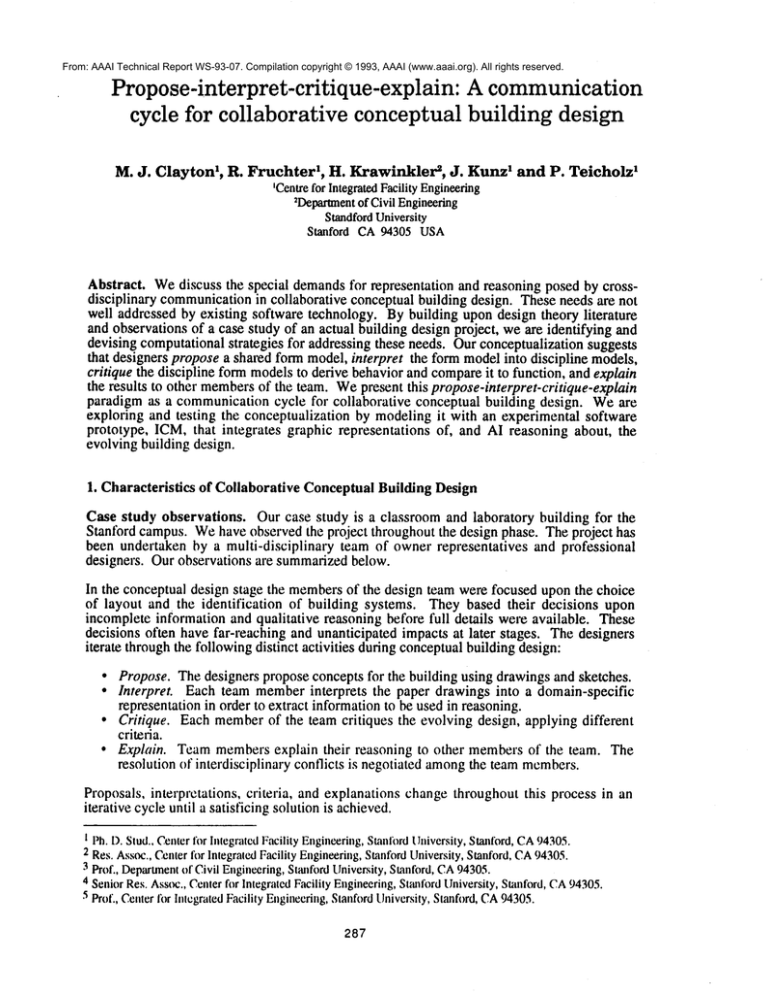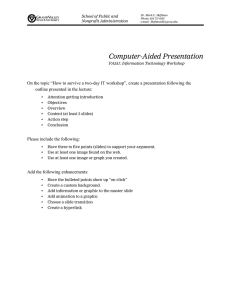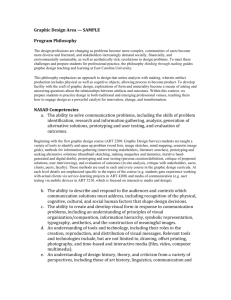From: AAAI Technical Report S-9 -0 . Compilation copyright © 199
advertisement

From: AAAI Technical Report WS-93-07. Compilation copyright © 1993, AAAI (www.aaai.org). All rights reserved. Propose-interpret-critique-explain: A communication cycle for collaborative conceptual building design M. J. Claytonz, R. Fruchter z, H. Krawinkler2, J. Kunzz zand P. Teicholz tCentre for Integrated Facility Engineering 2Departmentof Civil Engineering Standford University Stanford CA 94305 USA Abstract. Wediscuss the special demandsfor representation and reasoning posed by crossdisciplinary communication in collaborative conceptual building design. Theseneeds are not well addressed by existing software technology. By building upon design theory literature and observationsof a case study of an actual building design project, weare identifying and devising computationalstrategies for addressing these needs. Ourconceptualization suggests that designers proposea shared formmodel, interpret the form modelinto discipline models, critique the discipline formmodelsto derive behaviorand compareit to function, and explain the results to other membersof the team. Wepresent this propose-interpret-critique-explain paradigm as a communicationcycle for collaborative conceptual building design. Weare exploring and testing the conceptualization by modelingit with an experimental software prototype, ICM,that integrates graphic representations of, and AI reasoning about, the evolvingbuilding design. 1. Characteristics of CollaborativeConceptualBuilding Design Casestudy observations. Our case study is a classroom and laboratory building for the Stantbrd campus.Wehave observed the project throughout the design phase. The project has been undertaken by a multi-disciplinary team of ownerrepresentatives and professional designers. Ourobservations are summarizedbelow. In the conceptual design stage the membersof the design team were focused uponthe choice of layout and the identification of building systems. They based their decisions upon incomplete information and qualitative reasoning before full details were available. These decisions often have far-reaching and unanticipated impacts at later stages. The designers iterate throughthe followingdistinct activities during conceptualbuilding design: ¯ Propose.Thedesigners proposeconcepts for the building using drawingsand sketches. ¯ Interpret. Each team memberinterprets the paper drawings into a domain-specific representationin order to extract informationto be usedin reasoning. ¯ Critique. Each memberof the team critiques the evolving design, applying different crltella. ¯ Explain. Teammembersexplain their reasoning to other membersof the team. The resolution of interdisciplinary conflicts is negotiated amongthe teammembers. Proposals, interpretations, criteria, and explanations changethroughoutthis process in an iterative cycle until a satisficing solutionis achieved. l 2 3 4 5 Ph.D. Stud., Center Ior Integrated Facility Engineering,Stanford University, Stratford, CA94305. Res. Assoc., Center fi)r Integrat~ Facility Engineering,Stanford University, Stanford, CA94305. Prof., Departmentof Civil Engineering, Stanford University, Stanford, CA94305. Senior Res. Assoc., Center for Integrated Facility Engineering,StamfordUniversity, Stanford, CA94305. Prof., Centerfor Integrated Facility Engineering,Stanford University, Stanfi)rd, CA94305. 287 Problems. There are problems in the typical conceptual design process that can lead to delays and decreases in design quality. These problems that occur during this iterative process of design include: ¯ Representing new proposals using paper drawings is a time-consuming activity. ¯ Interpreting the paper drawings for each discipline is error-prone and time-consuming due to inadequate support for representing and editing interpretations. ¯ Reasoning about multiple discipline criteria is a difficult task. Conventional methodsof critique can neither be applied quickly or frequently, nor can designers address enough criteria to evaluate completelyall proposals. ¯ Explaining interdisciplinary issues is prone to misunderstanding due to the diversity of idioms used in different disciplines. Theory. In addition to the direct observations of designers at work, we have drawn heavily upon design theory literature, especially works by Asimow, Chandrasekaran, and Luth. Designers engage in three fundamental activities: synthesis, analysis and evaluation, and employ three conceptual models: form, behavior and function. (Asimow1962) (Luth 1991) In the synthesis stage, the designer or design team suggests a form for the artifact in response to a desired function. This form must be analyzed to determine its predicted behavior under particular environmental conditions. The behavior must be evaluated by comparing it back to the desired function. In the context of collaborative design, these activities can be seen as proposing a design to the membersof a design team whomust then critique it and modify it as necessary. (Chandrasekaran 1990) Figure 1 summarizes the cycle of synthesis, analysis and evaluation. A building design is synthesized into a single form model in response to functional requirements of different disciplines (e.g., architecture, structural engineering, mechanical engineering). The building design is then interpreted into multiple symbolic models for analysis in each discipline. The behaviors derived by analyses are then evaluated against the functions to initiate a repetition of the cycle. The cycle can be verbalized in terms of the three conceptual models by extending Louis Sullivan’s famous dictum "Form follows function," to become: form follows function follows behavior follows form. t Synthesis ~ EvaluaUon Figure 1. FormFollows Function Follows Behavior Follows Form This discussion of design models and activities leads to an insight into the particular problem in the development of computational tools for supporting design. The form of the building design is most easily proposed, portrayed, and manipulated using graphic tools, while the function and behavior are most easily represented and manipulated by symbolic tools. A computer system for design must achieve the proper degree of integration between graphic and symbolic representations. 288 2. Research Approach We conjecture that a software environment for conceptual design may accelerate the conceptual design process by reducing turn-around time for critiques, improve the quality of conceptual design by applying design critiques that address more criteria more rigorously, and smoothenthe transition between conceptual design and later stages by integrating efforts in a shared electronic medium. Existing Computer Support. Graphic 3D CADsystems provide a form modeler and a visualization tool for proposing and modifying a design. However, they have no symbolic modeling capabilities to critique the design. Knowledge-based systems provide symbolic modelers that can reason about function and behavior. They are useful for critiquing the design, but do not provide a graphic meansfor modeling form. Proposed Solutions. Webelieve that conceptual collaborative design can be supported by software that integrates CADgraphics and knowledge-based critiquing tools. Such a software environment must allow the designers to: ¯ explore and illustrate interactively the form of proposed designs using a 3D CAD graphic system; ¯ add, remove, and alter interpretations of the design proposals interactively using functions integrated with the CADmodeler; ¯ obtain computer-assisted critiques about the function and behavior of the evolving design using symbolic modelsthat address multiple criteria ; ¯ illustrate the results of critiques to support explanations across the discipline boundaries of the various team membersusing formalized graphic idioms projected onto the CAD model. The key research issues are the second and fourth points. The interpretation step maps from the form model expressed graphically to multiple behavior models expressed symbolically. The explanation step maps behaviors and functions to graphic representations. Formal Approach. Conceptual building design is viewed in this study as an incremental, iterative, and collaborative process amongthe design team members. Wesuggest a proposeinterpret-critique-explain paradigm to formalize the communicationcycle taking place in this design process. The central activities and models defined tbr the developmentof a prototype are: ¯ Building form model. A shared 3D graphic representation of a proposed design consisting of the union of all discipline graphic models. These models contain primarily information regarding the topological connectivity relations and the geometry of graphic entities. ¯ D&cipline form model. A representation of the design attuned to the needs of a single discipline resulting from the interpretation of the building form model and its instantiation into a symbolic model. ¯ Interpretation. Semantic annotation of CADgraphic entities of the 3D building form model that represents the meaningfrom the perspective of a discipline (e.g., architecture or structural engineering). An interpretation is explicit and dynamicin the sense that the annotations may be inspected, portrayed, manipulated and changed. Interpretations provide a one-to-many relationship between a graphic entity and its instances in multiple discipline models. ¯ Critique. A knowledge-based analysis and evaluation of a discipline model deriving behavior from the form, and comparing the behavior to function. The behavior of a 289 discipline model is derived by perfi~rming qualitative and quantitative analysis. The function is determined by the designer and by discipline design requirements. Explanation. An explanation consists of a symbolic trace of the causes that lead to a performance problem identified in the critique stage, and their visualization in the context of the building model. Communication. An expression of the impact of design decisions and consequences from one discipline onto another. Communication entails a full cycle of proposeinterpret-critique-explain activities. Prototype. In order to support these activities and models for conceptual building design, we are developing a prototype system, ICM(Interdisciplinary Communication Medium). The prototype assists an architect and a structural engineer in communicating and negotiating design concepts and decisions. The implementation of ICMemploys AutoCADto describe the form of the building model and the graphic discipline models, and KEEand Prokappa as knowledge engineering environments for symbolic modeling and reasoning about function and behavior. ICMlinks form, function, and behavior by integrating the following modules: 1. Geometric and Graphic Modeler (i.e., AutoCAD),which supports the representation of the building model form; 2. Interpretation Manager, which supports parsing the building model into graphic discipline models and linking them to symbolic discipline models ; 3. Knowledge-Based Critiquing Tools, which support the representation of symbolic discipline models and reasoning about these models to provide critiques about their function and behavior (e.g., QLRS*reasoning tool developed in KEE(Fruchter 1992), and Egl’css.~ reasoning tool developed in Prokappa); 4. Explanation Manager, which facilitates the composition of graphic function and graphic behavior models based on the critique results, and the projection of these models onto the building model; Figure 2 shows a sample of these modules. Negotiation and communication between the two team membersis facilitated by use of the above modulesin the iterative design process. 3. Implications The ongoing research concentrates on enhancing the conceptual framework and the prototype system by: ¯ raising the quality of knowledge-basedcritiques that are applied to the design proposals, ¯ exploring the use of graphical diagrams to explain the results of reasoning, and ¯ providing automated functions to identify interactions amonginterpretations of the building form. A key asset of the presented approach is that the users play an active role in the proposal of a "design, while taking advantage of the computer support for evaluating design proposals and communicating critique results across disciplines. By making interpretation explicit, ICM accommodates the creative and personal use of graphic representations and innovative mappings of form to behavior models. Furthermore, incorporating conceptual models in electronic mediashould enable the use of these modelsin the later stages of design. * QLRS is a critiquingtool for qualitativeinterpretationof lateral loadresistingframestructures. § Egressis a critiquingtool for reasoningaboutcirculationsystemsin an architecturalmodel. 290 Cr(ttclues: Problms: S~ Htde Select Purge Md Remove |dent1fy F|nd Figure 2. Sampleof tile Four ModulesoflCM: (1) illustrates an architectural CADmodel of the building fonn, (2) showsthe Interpretation Manager,(3) illustrates the symbolicobjects hierarchy of an egress critiquing system, (4) showsthe ExplanationManager. Acknowledgments This research is supportedby the Center for Integrated Facility Engineeringat Stanford, Seed Research Grant # AI9103. References Asimow,W., (1962) Introduction to Design, Prentice-Hall, Erlglewood Cliffs, NJ. Chandrasckaran, B., (1990) Design Problem Solving: A Task Analysis, A1 Magazine, AAAI, Menlo Park, CA, Winter 1991): 59-71. Fruchter, R. and Krawinkler, H., (1992) QLRS:An Approach for Qualitative Interpretation Lateral Load Resisting Systems The 8th ASCEConference Computing in Civil Engineering, ed. by B.J. Goodnoand J.R. Wright, Dallas, 253-260. Luth, G.P., (1991) Representation and Reasoning for Integrated Structural Dissertation, Departmentof Civil Engineering, Stanford University. 291 Design, Ph.D.



